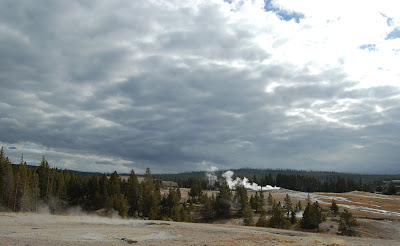The new visitor center at Old Faithful is clean, large, and professional. there is a huge theater set up with interpretive displays galore. There is information on the mechanics of the geysers, paleontology, flora and fauna. You can find information on the ecology of the hot springs. Yes, there are plants and critters that live in and around the water. You can also learn about scientific research in the area. Information is not just for adults, a children’s exhibit is on display as well. There is a fabulous virtual center here http://mms.nps.gov/yell/ofvec/index2.htm
Over-mineralization from the geysers has caused these dead pine trees to look white. Most of the pine that thrive around the thermal areas are lodge pole.
 In my previous post I thought ‘what about those early visitors who may have drunk the water-what happened to them?’ Here is why we know not to drink it directly now, it is full of bicarbonates (not so bad), chloride-mmmm, arsenate- beware!, sulfuric acid, and sodium. Most of these minerals end up as deposits along flows that create what I call hard ‘bubbles’ and white cascades. The most dramatic are from the carbonate springs.
In my previous post I thought ‘what about those early visitors who may have drunk the water-what happened to them?’ Here is why we know not to drink it directly now, it is full of bicarbonates (not so bad), chloride-mmmm, arsenate- beware!, sulfuric acid, and sodium. Most of these minerals end up as deposits along flows that create what I call hard ‘bubbles’ and white cascades. The most dramatic are from the carbonate springs.Some of the microbes that live in the water give the hot pots their bright colors. (The same was true of the water flow at Thermopolis). Guess what these bacteria, algae, and protozoa are called? Extremophiles! As the display says “what else could live in water filled with baking soda or acidic enough to burn holes in clothing?”
While these intense levels of minerals and strange micro-organisms may not be good for us to ingest, they are good for the greater macro-environment. The substances flowing out of the thermals supply rivers and habitats downstream with nutrients for plant growth and food for larger insects and fish.
OK, that was everyone’s basic education on how our environments are intertwined!
Kind of gives you an idea of how agates are formed.










No comments:
Post a Comment
Do you have a memory of this place to share? Or, would you visit after ready my account?